OSCQR standards 2, 3, 29, 38, 39, 41, 43, specifically address Regular and Substantive Interaction (RSI) standards. 2. Course provides an overall orientation or overview,…
Course provides learners with opportunities in course interactions to share resources and inject knowledge from diverse sources of information with guidance and/or standards from the…
Course offers opportunities for learner to learner interaction and constructive collaboration. Review These Explanations Collaboration in an online course fosters constructive learning by…
Course provides activities intended to build a sense of class community, support open communication, promote regular and substantive interaction, and establish trust (e.g., ice-breaking activities,…
Learners have an opportunity to get to know the instructor. Review These Explanations Social presence is the ability of learners to project their…
Expectations for all course interactions (instructor to student, student to student, student to instructor) are clearly stated and modeled in all course interaction/communication channels. Review…
Regular and substantive instructor-to-student expectations, and predictable/scheduled interactions and feedback, are present, appropriate for the course length and structure, and are easy to find. Review…









